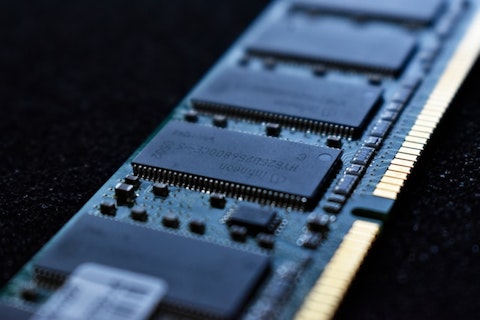Micron Technology, Inc. (NASDAQ:MU) Q2 2023 Earnings Call Transcript March 28, 2023
Operator: Thank you for standing by, and welcome to Micron’s Second Quarter 2023 Financial Call. . I would now like to introduce your host for today’s program, Farhan Ahmad, Vice President, Investor Relations. Please go ahead, sir.
Farhan Ahmad: Thank you, and welcome to Micron Technology’s Fiscal Second Quarter 2023 Financial Conference Call. On the call with me today are Sanjay Mehrotra, our President and CEO, and Mark Murphy, our CFO. Today’s call is being webcast from our Investor Relations site at investors.micron.com, including audio and slides. In addition, the press release detailing our quarterly results has been posted on the website, along with the prepared remarks for this call. Today’s discussion of financial results is presented on a non-GAAP financial basis, unless otherwise specified. A reconciliation of GAAP to non-GAAP financial measures may be found on our website. We encourage you to visit our website at micron.com throughout the quarter for the most current information on the company, including information on financial conferences that we may be attending.
You can also follow us on Twitter, @MicronTech. As a reminder, the matters we are discussing today include forward-looking statements regarding market demand and supply, our expected results and other matters. These forward-looking statements are subject to risks and uncertainties that may cause actual results to differ materially from the statements made today. We refer you to the documents we filed with the SEC, including our most recent Form 10-K and 10-Q, for a discussion of the risks that may affect our future results. Although we believe that the expectations reflected in the forward-looking statements are reasonable, we cannot guarantee future results, levels of activity, performance or achievements. We are under no duty to update any of the forward-looking statements to conform these statements to actual results.
I’ll now turn the call over to Sanjay.
Sanjay Mehrotra: Thank you, Farhan. Good afternoon, everyone. Micron delivered fiscal second quarter revenue within our guidance range, and excluding the impact of inventory write-downs, margins and EPS were also within the guidance range. The semiconductor memory and storage industry is facing its worst downturn in the last 13 years with an exceptionally weak pricing environment that is significantly impacting our financial performance. We have taken substantial supply reduction and austerity measures, including executing a company-wide reduction in force. We now believe that customer inventories have reduced in several end markets, and we see gradually improving supply-demand balance in the months ahead. Excluding the impact of inventory write-downs, we believe our balance sheet DIO has peaked in fiscal Q2, and we are close to our transition to sequential revenue growth in our quarterly results.
We are navigating the near-term difficult environment with our strong technology position, deep manufacturing expertise, strengthening product portfolio, solid balance sheet and incredibly talented team. Beyond this downturn, we anticipate a return to normalized growth and profitability in line with our long-term financial model. Micron continues to lead the industry in both DRAM and NAND technology. We are investing prudently to maintain our technology competitiveness while managing node ramps to reduce our bit supply and align it with demand. In DRAM, 1-alpha represents most of our DRAM bit production, and we continue to make great progress in initiating our transition to 1-beta. In NAND, 176-layer and 232-layer now represent more than 90% of NAND bit production.
We also continue to lead the industry in QLC. QLC accounted for over 20% of our NAND bit production and shipments in fiscal Q2. The Micron team’s solid execution and implementation of smart manufacturing has driven superb yield enhancement across our leading-edge nodes. Yields on 1-alpha DRAM and 176-layer NAND have reached levels that are now higher than any node in our history. In addition, both our 1-beta DRAM and 232-layer NAND have reached targeted yields ahead of schedule and faster than any of our prior nodes. We are well positioned to qualify these leading-edge nodes across our product portfolio and will ramp them based on customer demand. We are also making good progress towards the introduction of our EUV-based 1-gamma node in 2025.
Similar to our 1-alpha and 1-beta nodes, we expect this node to provide us with competitive performance, power, cost and density improvements. Now turning to our end markets. As a result of inventory adjustments across our end markets, slowing demand growth and an extremely challenging pricing environment, revenue was down year-over-year in all end markets. While our industry faces significant near-term challenges, we believe that the memory and storage TAM will grow to a new record in calendar 2025 and will continue to outpace the growth of the semiconductor industry thereafter. Recent developments in AI provides an exciting prelude to the transformational capabilities of large language models, or LLMs, such as ChatGPT, which requires significant amounts of memory and storage to operate.
We are only in the very early stages of the void split deployment of these AI technologies and potential exponential growth in their commercial use cases. As more applications of this technology proliferate, we will see training workloads in the data center supplemented with voice spread influence capabilities in the data center as well as in end user devices, all of which will drive significant growth in memory and storage consumption. In data center, we believe that our revenue bottomed in fiscal Q2, and we expect to see revenue growth in fiscal Q3. Data center customer inventories should reach relatively healthy levels by the end of calendar 2023. We continue to see AI as a secular driver of demand growth in the data center. An AI server today can have as much as 8x the DRAM content of a regular server and up to 3x the NAND content.
We are well positioned to capture the memory and storage opportunities that AI and data-centric computing architectures will provide. Our product roadmap includes exciting HBM3 and CXL innovations, and I look forward to sharing more details about these solutions in the future. In fiscal Q2, we expanded shipments of CXL DRAM samples to OEM customers that service enterprise, cloud and HPC workloads. Micron is leading the industry with world-class DDR5, or D5 technology. We are shipping D5 in high volume to data center customers and achieved our first customer qualification for our 1-alpha 24-gigabit D5 product. The latest generation of server processors, AMD’s Genoa and Intel’s Sapphire Rapids, require D5 DRAM. Servers using these new processes will drive higher D5 industry bit demand in second half of calendar 2023, towards mix crossover with D4 in mid-calendar 2024.
In fiscal Q2, we also began volume production and shipments of the fastest PCIe Gen4x4 NVMe SSD in the market, our 9400 176-layer performance NVMe data center SSD, which excels in AI and high-performance computing workloads. In PCs, we now forecast calendar 2023 PC unit volume to decline by mid-single-digit percentage, returning PC unit volume to pre-COVID levels last seen in 2019. Although still elevated, client customer inventories have improved meaningfully, and we expect increased bit demand in the second half of the fiscal year. With our strong product lineup, we are well positioned for the ongoing industry transition to D5. Client’s D5 adoption is expected to gradually increase through calendar 2023, with D4 to D5 mix crossover in early to mid-calendar 2024.
In fiscal Q2, our NAND QLC bit shipment mix reached a new record for the second consecutive quarter, driven by growth in both client and consumer SSDs. We qualified our Micron 2400 SSD, the world’s only 176-layer QLC SSD qualified at OEMs, across the client customer base. In graphics, industry analysts continue to expect graphics TAM growth CAGR to outpace the broader market supported by applications across client and data center. Customers’ inventory adjustments are progressing well, and we expect demand in the calendar second half of 2023 to be stronger than the first half. As the performance leader in graphics, we are excited to see our proprietary 16-gigabit G6X featured in the recently launched NVIDIA RTX 4070 Ti. In mobile, we now expect calendar 2023 smartphone unit volume to be down slightly year-over-year.
While some customer inventories are back to normal levels, other OEMs’ inventories remain elevated. In aggregate, we expect mobile customer inventory to improve through the remainder of calendar 2023, and we expect growth in mobile DRAM and NAND bit shipments in the second half of our fiscal year versus the first half. In fiscal Q2, we continued sampling and qualifying our industry-leading 1-beta 16-gigabit LP5X, receiving very positive feedback on its power, performance and quality from customers. We expect to generate revenue on this 1-beta product later this fiscal year. We showcased our leading products earlier this month at Mobile World Congress, where we displayed 8 flagship mobile customer design wins. Last, I’ll cover the auto and industrial end markets, which now represent over 20% of our revenue and contribute more stable revenue and profitability.
Micron is the market share leader in these important and fast-growing markets. In fiscal Q2, auto revenue grew approximately 5% year-over-year. Our leadership in automotive was evidenced by several milestones in Q2. We reached a new record customer quality score, qualified the industry’s first 176-layer e.MMC 5.1 automotive product, and began shipping the industry’s first 176-layer UFS 3.1 automotive solution. We expect continued growth in auto memory demand for the second half of calendar 2023, driven by gradually easing nonmemory supply constraints and increasing memory content per vehicle. The industrial market continued to soften in Q2, as our distribution channel partners reduce their inventory levels and end demand weakened for some customers.

Photo by Liam Briese on Unsplash
Inventories are starting to stabilize at the majority of our customers, and we expect demand to improve in the second half of our fiscal year. In our fiscal second quarter, Micron achieved advanced startup sampling and design-in across automation OEMs, ODMs and integrators with our latest generation of products. Now turning to our market outlook. Our expectations for calendar 2023 industry bit demand growth have moderated to approximately 5% in DRAM and low-teens percentage range in NAND, which are well below the expected long-term CAGR of mid-teens percentage range in DRAM and low-20s percentage range in NAND. The reduction in calendar 2023 demand from our prior forecast is driven by an assessment of customer inventories as well as some degradation in end market demand.
We expect that improving customer inventories will support sequential bit demand growth for DRAM and NAND through the calendar year. China’s reopening is also a positive factor for calendar 2023 bit demand. Public reports indicate that there have been significant CapEx cuts throughout the industry, and utilization rates have declined at all DRAM and NAND suppliers. We now expect that the industry bit supply growth for DRAM and NAND in calendar 2023 will be below demand growth, which will help improve supplier inventories. While the supply-demand balance is expected to gradually improve due to the high levels of inventories, industry profitability and free cash flow are likely to remain extremely challenged in the near term. Market recovery can accelerate if there is a year-to-year reduction in production or, in other words, negative DRAM and NAND industry bit supply growth in 2023.
In response to the industry environment, Micron has taken a number of decisive actions in fiscal 2023. First, we are further reducing our supply. We have made additional reductions to our fiscal 2023 CapEx plan and now expect to invest approximately $7 billion, down more than 40% from last year, with WFE down more than 50%. In fiscal 2024, we expect WFE to fall further as we ramp 1-beta and 232-layer nodes in a capital-efficient manner. We have further reduced DRAM and NAND wafer starts, which are now down by approximately 25%. As a result, for calendar 2023, we now expect Micron’s year-on-year bit supply growth to be meaningfully negative for DRAM. We also expect to produce fewer NAND bits in calendar 2023 than in calendar 2022. Excluding the impact of inventory write-downs, we expect Micron’s DIO to decline sequentially going forward from its peak in the second quarter.
Second, we have made further reductions to our operating expenses beyond the executive salary cuts and suspension of Micron’s fiscal 2023 bonuses company-wide. We now expect our overall headcount reduction to approach 15%. This will occur through a combination of workforce reductions, which are now largely complete as well as anticipated attrition through the remainder of the year. Third, Micron continues to execute to a strategy of maintaining flat annual bit share in both DRAM and NAND. While we have had to reduce price to remain competitive in the market, we have not done so in an attempt to gain share. As such, share changes at customers are generally transitory. Lastly, we have taken additional steps to ensure ample liquidity. Mark will go into further detail.
Micron continues to have the strongest balance sheet among the pure-play memory and storage companies, and our strong liquidity will enable us to weather this downturn while ensuring our product and technology competitiveness. I will now turn it over to Mark.
Mark Murphy: Thanks, Sanjay. Fiscal Q2 results reflected challenging market conditions with continued deterioration in pricing and profitability. Total fiscal Q2 revenue was approximately $3.7 billion, down 10% sequentially and 53% year-over-year. Fiscal Q2 revenue included $114 million from an insurance settlement disclosed at the time we provided guidance. Fiscal Q2 DRAM revenue was $2.7 billion, representing 74% of total revenue. DRAM revenue declined 4% sequentially, with bit shipments increasing in the mid-teens percentage range and prices declining by approximately 20%. Fiscal Q2 DRAM bit shipments benefited from the timing of shipments between fiscal Q1 and fiscal Q2. Fiscal Q2 NAND revenue was $885 million, representing 24% of Micron’s total revenue.
NAND revenue declined 20% sequentially, with bit shipments increasing in the mid- to high-single-digit percentage range and prices declining in the mid-20s percentage range. Now turning to revenue by business unit. Compute and Networking Business Unit revenue was $1.4 billion, down 21% sequentially. And on a sequential basis, cloud revenue was down while client revenue was stable. Revenue for the Mobile Business Unit was $945 million, up 44% sequentially. Mobile revenue benefited from the timing of some shipments between fiscal Q1 and fiscal Q2. Embedded Business Unit revenue was $865 million, down 14% sequentially. On a sequential basis, automotive markets were relatively stable following industrial and consumer end markets experienced weakness.
Revenue for the Storage Business Unit was $507 million, down 25% sequentially and impacted by challenging conditions in the NAND market. Consolidated gross margin for fiscal Q2 was negative 31.4%. This result was negatively impacted by approximately $1.4 billion or 38.7 percentage points of inventory write-down recorded in the quarter. These noncash write-downs, which lower the cost basis of inventory, resulted — results from projected selling prices falling below the cost of inventory and are not the result of obsolescence. Operating expenses in fiscal Q2 were $916 million, down roughly $80 million sequentially. We continue to aggressively manage our operating expenses and expect them to decline sequentially in both fiscal Q3 and fiscal Q4.
We had an operating loss of roughly $2.1 billion in fiscal Q2, resulting in an operating margin of negative 56%, down from negative 2% in the prior quarter and positive 35% in the prior year. The operating loss included the $1.4 billion inventory write-down recorded in the quarter for a 39 percentage point impact to operating margin. Fiscal Q2 taxes were $53 million. As mentioned in previous quarters, despite a consolidated loss on a worldwide basis, we still have taxes payable in certain geographies due to taxable income levels reported in those geographies. Non-GAAP loss per share in fiscal Q2 was $1.91, down from a loss per share of $0.04 in the prior quarter and earnings per share of $2.14 in the prior year. Fiscal Q2 EPS included approximately $1.34 of losses from the impact of the inventory write-down.
Turning to cash flows and capital spending. We generated $343 million in cash from operations in fiscal Q2, representing approximately 9% of revenue. Capital expenditures were $2.2 billion during the quarter. We expect fiscal 2023 CapEx to be 2/3 front-half weighted, with a higher mix of construction spend in the second half. Free cash flow was negative $1.8 billion in the quarter. Our ending fiscal Q2 inventory was $8.1 billion and reflects the impact of the $1.4 billion write-down. Average days of inventory for the quarter was 153 days, and excluding write-downs, 235 days. Inventory levels and days are higher in NAND than DRAM. Our actions on supply reflect our intent to work down days of inventories from these levels. At quarter end, we held cash and investments of $12.1 billion and had total liquidity of $14.6 billion when considering our untapped credit facility.
Given macroeconomic uncertainty and the market environment, during the quarter, we bolstered our liquidity further through the addition of $1.9 billion of long-term debt. Our fiscal Q2 ending debt was $12.3 billion. Under a net debt position, our net interest income moves to net interest expense in Q3. Micron’s balance sheet is solid with ample liquidity, low net debt and a weighted average maturity on debt of December 2029. Now turning to our outlook for the fiscal third quarter. Market conditions remain extremely challenging. However, we expect that for the rest of this calendar year, DRAM and NAND bit shipments will continue to increase and supply-demand balance will gradually improve. Included in the fiscal third quarter guide is an insurance recovery, separate and unrelated to that recognized in fiscal Q2 of approximately $110 million, $70 million of which we expect to recognize as revenue.
In fiscal Q3, we expect gross margins to be negatively impacted by pricing, write-down of inventory, cost of underutilization and a higher mix of NAND. On write-down of inventory, our guidance assumes a write-down of approximately $500 million associated with inventory produced during fiscal Q3. Small changes to price expectations beyond fiscal Q3 could have a substantial positive or negative impact to the inventory write-down amount in fiscal Q3. Potential variances of inventory write-downs are not factored into the guidance ranges for gross margin and EPS. As market conditions remain weak, we will continue to aggressively manage our expense profile. As Sanjay mentioned, we increased our headcount reduction target to approach 15% from our previous target of approximately 10%.
We now expect OpEx to fall below $850 million in the fiscal fourth quarter of 2023. For nonoperating items, we expect net interest expense of approximately $5 million in fiscal Q3. We now project fiscal 2023 taxes to be less than $140 million. We expect profitability to remain extremely challenged in the near term. We do project profitability to improve sequentially due to lower inventory write-downs and free cash flow to improve slightly, driven by reduced capital spend. But we forecast operating margin and free cash flow to remain significantly negative through the fiscal year. With all these factors in mind, our non-GAAP guidance for the fiscal Q3 is as follows. We expect revenue to be $3.7 billion, plus or minus $200 million; gross margin to be in the range of negative 21%, plus or minus 250 basis points; and operating expenses to be approximately $900 million, plus or minus $15 million.
We expect tax expense of approximately $50 million. Based on a share count of approximately 1.09 billion shares, we expect EPS to be a loss of $1.58, plus or minus $0.07. In closing, we continue to aggressively manage through this period of challenging market conditions, preserving our competitive technology and product positions, strong operational capability and solid balance sheet. Following this downturn, we expect to capitalize on the secular demand trends and growth in memory and storage. We believe we are close to a transition to sequential revenue growth in our quarterly results. We are focused on significantly improving profitability and returning to positive quarterly free cash flow within fiscal 2024. We remain confident in our financial model, and we’ll continue to operate the business in a disciplined manner to generate long-term profitability, cash flow and shareholder returns.
Sanjay Mehrotra: Thank you, Mark. We are carefully managing our business to weather this industry downturn, preserving our technology and product portfolio competitiveness and manufacturing capabilities. Micron is the leader in DRAM and NAND process technology and one of only a handful of leading-edge semiconductor manufacturers in the world. Our team continues to drive new breakthroughs for our customers. Memory and storage are at the heart of systems and solutions that fuel the global economic engine, drive new efficiencies, create higher productivity and spud advances that make life better for people around the world. We look forward to a normalization of market conditions, and we remain confident in the long-term demand for our solutions based on the value they create across multiple end markets. Thank you for joining us today. We will now open for questions.
See also 11 Best Waste Management Stocks to Buy Now and 35 Most Beautiful Places In The World.
Q&A Session
Follow Micron Technology Inc (NASDAQ:MU)
Follow Micron Technology Inc (NASDAQ:MU)
Operator: . And our first question comes from the line of C.J. Muse from Evercore ISI.
Christopher Muse: I guess I was hoping to get your sense of how you’re thinking about the shape of the recovery. Obviously, things don’t look great today, but you’ve been through this before and will get through it. And so would love to hear your thoughts around how you think will come out of this. And given the CapEx cuts we’ve seen across the industry, it certainly looks like we’re going to be an undersupply situation, at least for DRAM in calendar ’24. I’m curious what some of your largest customers are saying today, particularly in the data center as they start to consider this likelihood.
Sanjay Mehrotra: Thanks, C.J., for the question. So I think we can look at the question from the demand and the supply point of view. And from the demand side, as we have indicated that we are seeing that the customer inventories are improving while still elevated, but in aggregate, customer inventories are improving. And we do expect that the volume of shipments, both for DRAM and NAND, will continue to increase on a sequential basis from here on. And of course, on the supply side, you have heard actions from industry players. And through various reports, you have seen that the CapEx reductions are being made as well as underutilization is being made in the industry. And that is going to be taking out a chunk of — will take a bite at the supply in the industry.
So basically, the supply trend will also begin to improve. So the demand and supply balance will gradually improve through the course of the year. We have said that inventory — we believe also days of inventory will continue to improve as well. For us, days of inventory peaked in Q2, and exclusive of inventory adjustments, we would expect days of inventory to continue to improve from here on. We have talked about for our business that we see being close to transition to sequential growth in revenue going forward. So overall the industry environment, with the demand and supply gradually improving, we expect the trajectory of pricing also to be improving. So this then ultimately means that while the profitability remains challenged, and yes, free cash flow remains challenged, but the fundamentals of the industry are beginning to improve.
And certainly, with the actions that have been taken, it could be that in 2024 timeframe that there could be shortages in the industry. But overall, Micron, I think, is taking decisive actions, as we have discussed, with respect to managing our CapEx, managing underutilization in the fab, managing OpEx and really focusing on supply growth as well. And in terms of some of the market trends and the customer trends that you’ve talked about, basically, we have shared that PC inventories are meaningfully better and will continue to improve over the next couple of quarters. Smartphones, some customers may have high inventory versus other customers, but inventories continue to improve in the smartphone market over a couple of quarters as well. Cloud revenue for us, we think, has bottomed in — at Q2 timeframe.





